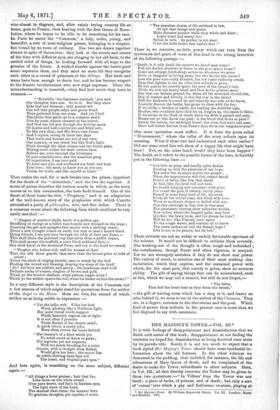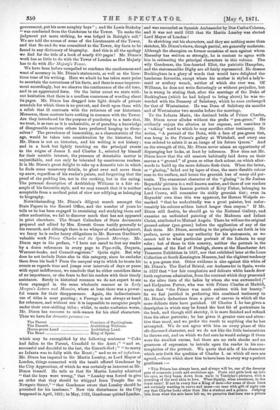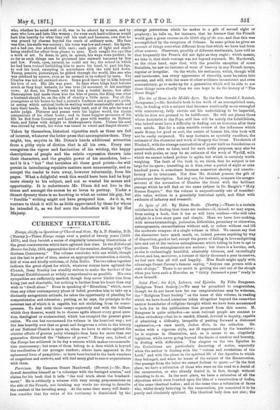HER MAJESTY'S TOWER.—VOL. III.*
IT is with feelings of disappointment and dissatisfaction that we finish each series of this work ; disappointment at not finding the contents we hoped for, dissatisfaction at being deceived once more by its pseudo-title. Surely it is not too much to expect that a book styled Her Majesty's Tower should have some incidental in- formation about the old fortress. In the other volumes we demurred to the padding, that included, for instance, the life and adventures of Mary Queen of Scots, and we complained of the desire to make the Tower subordinate to other subjects. Here, in Vol. III., all that directly concerns the Tower may be given in these two quotations :—"In Villiers' time the Tower was not itself i a place of racks, of poisons, and of death ; but only a sort of 'corner' into which a gay and frolicsome creature, playing at
• lier Mgiestis Tower. By William Hepworth Dixon. Ira IlL Loudon: Hunt and. Blaekett 1871.
government, put his more naughty boys " ; and Sir Lewis Stukeley "was conducted from the Gatehouse to the Tower. To make the judgment yet more striking, he was lodged in Raleigh's cell." We are told the names of some of the Lieutenants of the Tower, and that So-and-So was committed to the Tower, dry facts to be found in any dictionary of biography. And this is all the apology we find for the title of a book of nearly 400 pages ! Mr. Dixon's work has as little to do with the Tower of London as Her Majesty has to do with Her Majesty's Tower.
We have been before compelled to condemn the carelessness and want of accuracy in Mr. Dixon's statements, as well as the licen- tious tone of his writing. Here we admit he has taken more pains to ascertain the correctness of his facts, and there is some improve- ment accordingly, but we observe the continuance of the old tone, and in an aggravated form. On the latter count we state with- out hesitation that there is a needless coarseness of wording about its pages. Mr. Dixon has dragged into light details a private scandals for which there is no pretext, and dwelt upon them with a relish that ill contrasts with the reticence of our historians. Moreover, these matters have nothing in common with the Tower. Are they introduced for the purpose of pandering to a taste that, we trust, is as rare as it is undesirable, or of parading a knowledge of disagreeable matters others have preferred keeping to them- selves? The prevalence of immorality, as a characteristic of the age, would be taken into consideration by the historian, but Mr. Dixon is not an historian, and his writing is not history ; and in a book but lightly touching on the principal events in the reigns of James I. and Charles I., selected by himself for their notable interest, the presence of detestable matter is unjustifiable, and can only be tolerated by omnivorous readers. It is Mr. Dixon's great delight to rake up a domestic tale in which he finds some unsavoury details, to gloat over and serve them up anew, regardless of his reader's palate, and forgetting that the proof of the pudding lies, not in the cooking, but in the eating. The personal description of Archbishop Williams is a fair ex- ample of his favourite style, and we may remark that it is neither acceptable from a medical point of view nor edifying as belonging to biography.
Notwithstanding Mr. Dixon's diligent search amongst the State Papers in the Record Office, and the number of years he tells us he has been engaged in examining and studying them and other authorities, we fail to discover much that has not appeared in print elsewhere. The Stuart Calendars of State documents prepared and edited by Mrs. Everett Green testify generally to his research, and although there is no whisper of acknowledgment, we fancy he is under heavy obligations to Mr. Rawson Gardiner's valuable work Prince Charles and the Spanish Marriage. Mr. Dixon says in his preface, "I have not cared to fret my reader by a dozen references in every page to Pipe-rolls, Doquets, Warrant-books. and Council-registers." Quite right. But why does he not include Dates also in this category, since he excludes them from his book? From the unequal way in which he treats his events as regards time and jumps over intervals of days or years with equal indifference, we conclude that he either considers dates of no importance, or else fears to fret his readers with their timely assistance. Surely in historical romance we do not expect to see them expunged in the same wholesale manner as in Lady Morgan's Letters and Memoirs, where at least there was a power- ful reason for their disappearance. Again, the indiscriminate use of titles is most puzzling ; a Peerage is not always at hand for reference, and without one it is impossible to recognize people under their ever-shifting titles ; whilst, to make confusion worse, Mr. Dixon has recourse to nick-names for his chief characters. Thus we have for dramatis personw
Countess of Backingham.
Archbishop Williams.
Archbishop Laud. King of Spain.
which may be exemplified by the following sentences "Coke had fallen to the Parent, Cranfield to the Aunt ;" "and so, successful and deceitful to the last, the Eunuch died ; " "to marry an Infanta was to dally with the Beast ;" and so on ad infinitum. Mr. Dixon has imputed to Sir Martin Lumley, as Lord Mayor of London, things connected with the insult offered Gondomar by the City Apprentices, of which he was certainly as innocent as Mr.
Dixon himself. He tells us that Sir Martin Lumley admitted "that the boys were wrong," that "Lumley was forced to give an order that they should be whipped from Temple Bar to Newgate Street," "that Gondomar swore that Lumley should be punished for his insolence." Now this disturbance in the City happened in April, 1621; in May, 1622, Gondomar quitted London,
The Parent The Eunuch Hocus-pocus Laud The Beast
and was succeeded as Spanish Ambassador by Don Carlos Colorna, • .and it was not until 1623 that Sir Martin Lumley was elected Lord Mayor of London !
In sketching out his characters, and they are nothing more than sketches, Mr. Dixon's views, though partial, are generally moderate.
Although the champion on former occasions of men against whom Macaulay has written so strongly, he is content to agree with, him in estimating the principal characters in this volume. The- wily Gondomar, the lion-hearted Eliot, the patriotic Hampden, and the statesmanlike Digby are all fairly represented. He dresses. Buckingham in a glory of words that would have delighted the- handsome favourite, except where his mother is styled a lady's-
maid or scullery wench, neither of which she ever was. Of
Williams, he does not write flatteringly or without prejudice, but he is wrong in stating that, after the marriage of the Duke of Buckingham (which he had helped to bring about) he was re-. warded with the Deanery of Salisbury, which he soon exchanged for that of Westminster. He was Dean of Salisbury six months and of Westminster two months before the marriage.
To the Infanta Maria, the destined bride of Prince Charles,. Mr. Dixon never alludes without the prefix "pea-green." He enjoys the allusion at her expense, and considers it a ' taking ' word to which he may sacrifice other testimony. He writes, "A portrait of the Dona, with a face of pea-green tint, was hung in the Prince's gallery at Whitehall, and every one was ordered to salute it as an image of his future Queen." An on the strength of this, Mr. Dixon never misses an opportunity of disparaging her looks, at least by inference. Now does not Mr. Dixon know that the old masters habitually laid down on their canvas a " ground " of green or other dark colour, on which after- wards to build up the more delicate flesh-tints. When the latter, or "glazing," faded out by lapse of time, the more durable colour- rose to the surface, and hence the greenish. hae of many old por- traits. The evanescent character of the " glazing " in Sir Joshua Reynolds' pictures is a well-known matter, and those of our readers who have seen his famous portrait of Kitty Fisher, belonging to. Lord Crewe, will remember its sickly greenish tint ; even in Reynolds' own time this was apparent, for Horace Walpole re- marked "that he undoubtedly was a great painter, but unfor- tunately his colours seldom lasted longer than crayon." If Mr.
Dixon still doubts, he should go to the National Gallery, and examine an unfinished painting of the Madonna and Infant Christ, attributed to Michael Angelo. There he will see the original ground-colour (pea-green) before the application of any of the flesh tints. Mr. Dixon, according to the principle set forth in his preface, never quotes any authority for his statements, so we cannot tell to what particular portrait of the Infanta he may refer ; but of those in this country, neither the portrait in the possession of the Earl of Denbigh, shown at the Manchester Art Treasures Exhibition in 1857, nor that exhibited later at the Loan Collection at South Kensington Museum, had the slightest tendency to a pea-green tint. Other evidence is also against this whim of Mr. Dixon's. The Earl of Bristol, our Ambassador in Spain, wrote in 1622 that "her fair complexion and delicate white hands drew forth rapturous admiration, from the contrast which they presented
to the olive tints of the ladies by whom she was surrounded and Endyinion Porter, who was with Prince Charles at Madrid, wrote that "the Prince was much smitten with her beauty." So we feel justified in preferring this combined testimony to. Mr. Dixon's deductions from a piece of canvas in which all the more delicate tints have perished. Of Charles I. he has given a.
description in which may be found the best bit of portraiture in the book, and though still sketchy, it is more finished and refined than his other portraits ; he has given it greater care and atten- tion than usual, and we prefer the result to anything else he has. attempted. We do not agree with him on every phase of this oft-discussed character, and we do not like the little insinuations
he throws out, and on which we feel sure he would enlarge if there were the smallest excuse, but there are no rude shocks and no. grossness of expression to intrude upon the reader in his con-
templation of the portrait. We quote that aide of his character which sets forth the qualities of Charles I. on which all men are agreed,—those which show him to have been in every way a perfect.
gentleman :—
"This Prince has alwayis been, and always will be, one of the dreamy pets of romantic youth and credulous age. Poets and girls look up into. his eyes, as they beam down from walls in Vandyke's pictures, with a. yearning of the soul akin to love. What dignity, what sweetness, in the royal saint! If not in every line a King of men—for some of these lines are certainly wanting in curve and -mass—no man with gift of sight can say that Charles looks other than like a student and a prince. Judging him from what the arts have left us, we perceive that here was a prince, who, whether he acted well or ill, was to be adored by women, and by men who love and hate like women ; for even such hard critics as would lash him heavily for what they call his craft and baseness, own that he was graced by charms beyond the reach of ordinary men, His face was fine; his smile was sorcery ; his voice was low and sweet; his figure, not a bad one, was adorned with care ; each point of light and shade being studied for effect from plume to spur. Each caught the eye like a work of art. In dress, in gait, in speech, his ways were perfect ; in so far as such things can be governed into outward harmony by line and law. Frank, open, natural, he could not be; the school in which he had been trained forbidding him to move his hand, to part his lips, to nod his head, excepting in accordance with the rule laid down. Young, pensive, picturesque, he glided through the world, like one who was subdued by sorrow, oven as he seemed to be refined by taste. Yet Charles was not all outward show. Some good there lay in hiin beyond his love of art. His life was pure. In days when kings kept harems much as they kept kennels, he was true (in measure) to his marriage vows. At first, his French wife led him a fretful dance ; but after Bassompiere had made them kiss the kiss of peace, the King was what a husband should be, on the side of charity a little more. For all the youngsters at his knees he had a parent's fondness and a parent's pride, at seeing which satirical lords-in-waiting would occasionally smile and turn their heads. In books he was fairly read, and of the arts he was a noble judge. Pictures and poems were his higher world, the choice companions of his silent hours ; and in these happier moments of his life he fled from Coventry and Land to gaze with wonder on Ruben& tints, and listen with delight to Shakespeare's lines. Unless his sent was stirred by wrath, his voice was tuned to sweet and limpid chords."
Taken by themselves, historical vignettes such as these are full .of interest, whatever the letter-press that accompanies them. They might, too, acquire in Mr. Dixon's hands additional attraction from a pithy style of diction that is all his own. Every one recognizes the vigour and fascination of his writing, the happy descriptions of people and the subtle expression thrown into their characters, and the graphic power of his anecdotes, but— and it is a " but" that tarnishes all these good points—he will persist in introducing repulsive matters most unnecessarily, and so 'compel the reader to turn away, however reluctantly, from his pages. What a delightful work this would have been had he kept more closely to his subject, and not so wasted his means and .opportunity. It is unfortunate Mr. Dixon did not live in the times and amongst the scenes he so loves to portray. Under a Stuart dynasty there is no knowing to what an extent his gay, but 4' forcible" writing might not have prospered him. As it is, we venture to think it will be as little appreciated by those for whom be intended it, as we feel sure the dedication will be by Her Majesty.


































 Previous page
Previous page